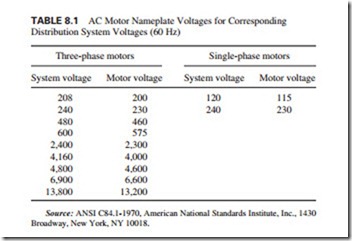APPLICATION DATA
The first step in obtaining and maintaining adequate motor performance is the proper application of motors in accordance with their service conditions, which are designated as usual and unusual, by NEMA.
Usual Service Conditions
Environment
1. Exposure to an ambient temperature in the range of 0 to 40°C (32 to 104°F) or, when water cooling is used, from 10 to 40°C (50 to 104°F)
2. Exposure to an altitude which does not exceed 3300 ft
3. Installation on a rigid mounting surface
4. Installation in areas or supplementary enclosures which do not seriously interfere with the motor’s ventilation
Operating
1. V-belt drive in accordance with NEMA standard MG1-14.41 for ac motors or with NEMA Standard MG-1-14.67 for industrial dc motors
2. Flat belt, chain, and gear drives in accordance with NEMA Standard MG-1-14.07
Unusual Service Conditions
1. Exposure to
a. Combustible, explosive, abrasive, or conducting dusts.
b. Lint or very dirty operating conditions.
c. Chemical fumes or flammable or explosive gases.
d. Nuclear radiation.
e. Salty air, steam, or oil vapor.
f. Damp or very dry locations, radiant heat, vermin infestation, or atmosphere con- ducive to the growth of fungi.
g. Abnormal shock, vibration, or mechanical loading from external sources.
h. Abnormal axial or side thrust imposed on the motor shaft.
2. Operating where
a. There is excessive departure from rated voltage and/or frequency.
b. The deviation factor of the ac supply voltage exceeds 10 percent.
c. The ac supply voltage is unbalanced by more than 1 percent.
d. The rectifier output supplying a dc motor has current peaks unbalanced by more than 10 percent.
e. Low noise levels are required.
3. Operations at speeds above the highest rated speed.
4. Operation in a poorly ventilated room or in an inclined position.
5. Operation where the motor is subjected to torsional impact loads, repetitive abnormal overloads, or reversing or electric braking.
6. Operation of the motor at standstill with any winding continuously energized.
The supply voltage must be known in order to select a motor for an application. Table shows the required voltage which should exceed the nameplate voltage by a small amount. Ideal power supplies provide constant voltage, frequency, and phasing. In reality, voltages vary from 10 percent above to 10 percent below the nominal values. The frequency is usually controlled within a tight tolerance, but it, too, can vary. Phasing, which is normally balanced when the voltage in each of the three phases is equal, can be unbalanced by a few percentage points.
